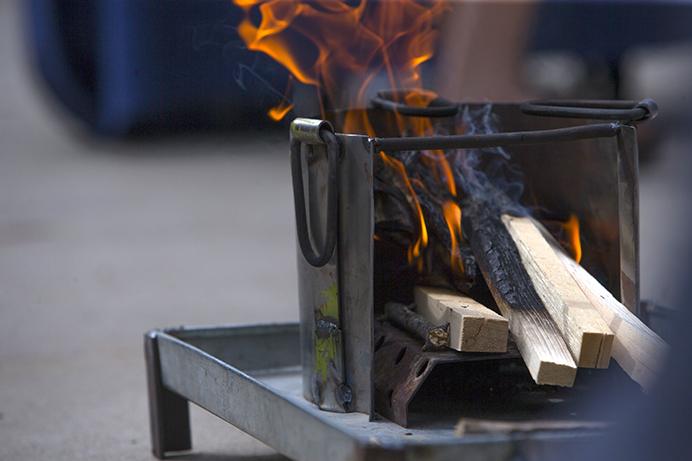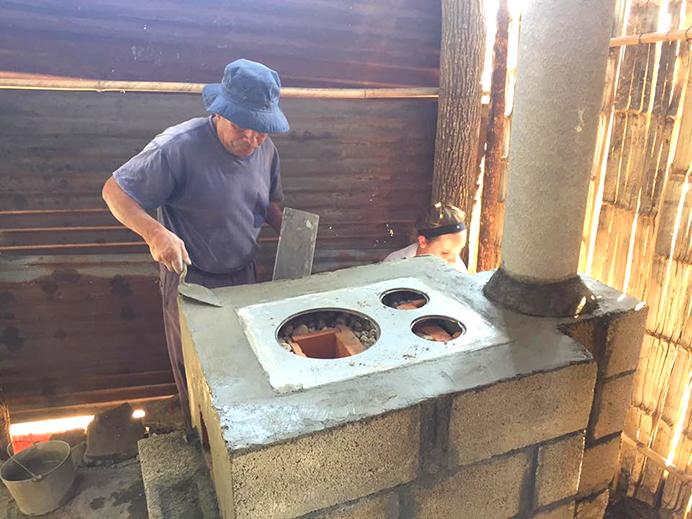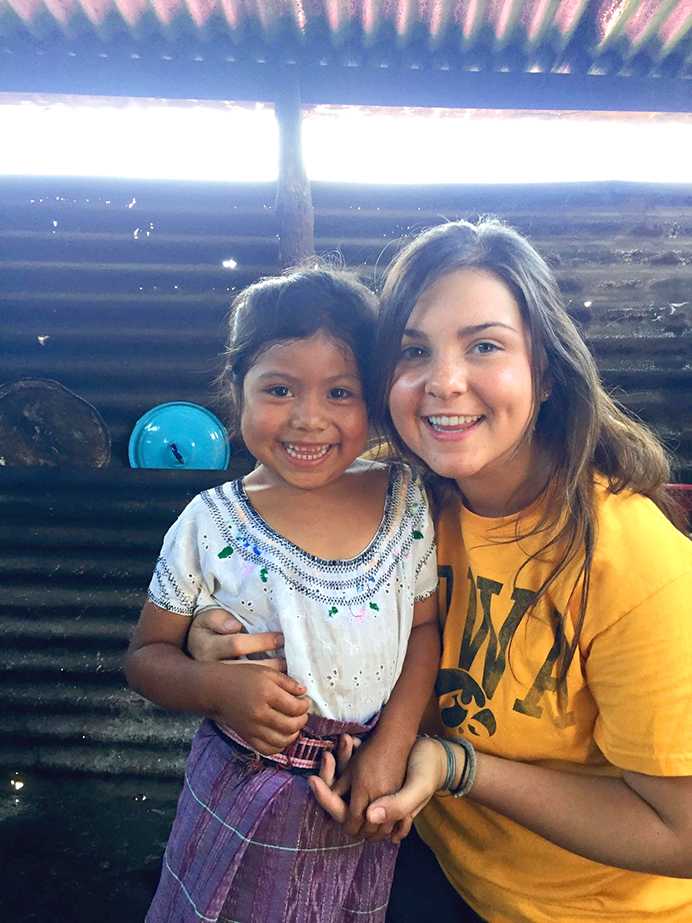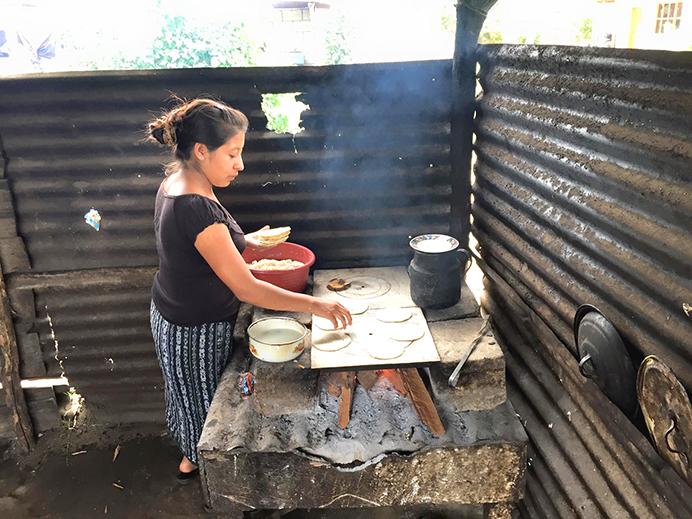Those of us who are lucky enough to travel abroad for mission trips typically come home with a new sense of values. At least that was my experience. Two recent adventures to Guatemala, in which I helped indigenous and Spanish natives in their communities, exposed me to completely new environments. And yet, I still find it hard to talk about these trips.
My fellow students, and some of my family members, might try to understand the stories I share, but I often come away from a conversation feeling as though no one really gets it. And I, in turn, know it can be hard to grasp something unrelatable.
This week I finally found a group in Iowa City that listens.
University of Iowa students Shanea Condon and Fidel Estrada shared with me their exposure to a health problem in India when they took a trip over winter break through a Fulbright scholarship. We met on the T. Anne Cleary Walkway as we watched a cooking-stove demonstration Wednesday. These stoves are part of a project developed by UI faculty who have the same goal: understand the health problems Indian women face that correlate with cooking stoves.

Though the people in the communities Condon and Estrada saw in India had different needs than the ones I met in Guatemala, we connected over having an unusual cultural awareness of an international problem.
This was the first real conversation like this I have had with students in America aside from the youth from my church who joined me on the Guatemala trips.
• • •
Growing up, I knew my home was smaller than some of my peers. The three-bedroom, two-bathroom house was nice and comfortable for my family — mom, dad, and two older sisters. But seeing bigger houses, or nicer home décor, gave me an idea that I was living more modestly than most.
Then I went to Guatemala on a mission trip.
Just as America has a range of class statuses, the homes I saw in Guatemala reflected different incomes. The villages I worked in included a variety of sizes. Some were built of concrete bricks, others had tin sheets or hand-tied branches as dividers. While the homes I went into were filled with love, a sense of community, and support for each other, I did not notice the excessive “stuff” that often ended up in piles in my room — such as old magazines, clothes I didn’t wear any more, or the stuffed animals from my childhood that I have just never gotten around to throwing away.
Spending my weeks visiting a number of families in these Guatemalan communities basically changed my entire perception of material possessions and how I value them. For instance, used clothing would circulate throughout these communities via trucks or shops; people would simply grab something off the back and try it on for size. Brands didn’t matter — there was no status involved with the label.
As for food, farmers set up their produce twice a week in a farmers’ market. Local stores featured a small selection of canned goods and potato chips.
Once I returned to Chicago, it suddenly became hard for me to walk into a grocery store and see so many options available from which to choose. And a trip to the mall became a reminder of how good I had it in America — to be able to access any required necessity at any time.
These memories came rushing back while speaking with my new, jet-setting, friends on the Cleary Walkway. We even got a little emotional sharing the struggles of realizing our abundance of resources in America.
We also connected on the difficulties explaining what we learned to our friends who don’t have that perspective, who aren’t as aware of our waste and the carbon footprint we leave on Earth compared with others who share this planet.
Condon and Estrada’s advice to me was to be an example to others by pushing the conversation and hope people listen to our stories. The issue of poor health, because of a lack of resources, is an everyday reality to some, so it is important for us to vocalize and get the message across.
Now I’ve found people in Iowa City who understand.
• • •
Stepping out of the airport in Guatemala City in 2015, I saw hundreds of people gathered by the exit doors holding welcome-home signs and balloons. I was told it is a cultural expectation to greet one’s family as they return from a trip, even if it means taking a bus to the airport from hours away. The 90-minute drive to our destination was an adventure in itself: local police stood on every city block holding their rifles; the buzzing of cars and mopeds whipping through traffic, but also the beautiful volcanic and mountainous scenery outside the city.
The inland village I worked in, El Porvenir, sat on a highway about 15 minutes from our hotel. The first time we drove in — we were all clustered together on the back of two pick-up trucks — we were greeted with streamers and fireworks as the townspeople invited us into their community and their homes. Our group was split into teams; I was partnered with a family and a mason to complete our mission: building them a new fuel-efficient stove.
Families in this village typically cooked on crumbling stoves — hazardous ones with no chimneys that produced open flames inside the homes, causing smoke to damage the tin or concrete walls. Family members inhaled the smoke daily, and children noticeably suffered; I witnessed them heaving and coughing daily. But this was their way of life. The family I was assigned to lived with several generations under their roof. Hundreds of tortillas were cooked daily on the decrepit old stoves.
In contrast, the stoves I was there to build were based on a safe model tested to last a lifetime — one with a chimney to force the smoke outdoors.
They were constructed with cinder blocks — machete-chopped and put in place by me and other volunteers — and glued together with concrete we hand-mixed. There was a slim slot for firewood so less oxygen hit the flame. The stove-top heat lasted longer and used less wood, too.

After completion, our new stove looked like a waist-high concrete box with a flat metal sheet perched on top for cooking. It seems simple, but the engineering behind it served a purpose.
• • •
In Guatemala, women like to stand as they cook. They prefer a large cooktop so many women can cook tortillas at the same time. In contrast, women in India prefer to sit, sometimes holding children in their laps, which is why their stoves sit low to the ground. Responding to cultural needs in these communities is the key to international social work.
Culture shock takes place when someone travels and adapts to a different lifestyle, no matter how long that experience is. Whether it’s the food, the language, or the way of life in a new area, all encompass some sort of discomfort.
My biggest adjustment wasn’t settling into this new environment in Guatemala. Yes, the food was different; the weather was different; people treated me differently. But I acclimated pretty quickly.
Rather, the biggest challenge was in coming back home after the mission trip. The challenges I faced in returning — this “reverse culture shock” — was unexpected and disconcerting, at least initially.
My bedroom, as one example, altered my values of “stuff.” My childhood bedroom has been the same since I was 2 years old. It has changed looks throughout the years, but currently the room contains two twin beds, a red loveseat, a dresser, yellow window curtains, and purple walls decorated with photographs, celebrity autographs, and inspirational quotes. Thrown about the room you’ll find a scrunched-up heated blanket, old Eric Church concert tickets, and a new shower speaker.
Once I returned home from being abroad, I sat in my room for a few moments just looking around at my “stuff.” Though appreciative, I didn’t think it was as cool as I once did, and quite frankly, I became embarrassed to admit these possessions were so highly valued in my life.
I couldn’t help but contrast my material existence with that of the lives I had left behind: lives filled with values similar to mine: a focus on the family, community, love, and acceptance of others. But their lack of material possessions seemed to make these values more prominent in their lives.
The phenomenon of reverse culture shock is the psychological, emotional, and cultural aspects of re-entry into one’s home turf. The U.S. Department of State’s website notes that a traveler’s own home can feel different upon return based on expectations.
That’s precisely how I felt.
Further, I expected my friends and family would want to learn about my trip as much as I wanted to share my stories. But I quickly learned I had to take the initiative. Of course I knew that life went on at home without me; what I did not know at the time was that posting photos on social media with what I viewed as heartfelt captions was simply not enough to share my experiences.
• • •
One 5-year-old girl named Leila has been stuck in my mind since I first met her in her village during my first trip. I connected with most of the locals and the homeowners I worked with, but Leila tugged on my heart the most.
The first day I set foot in her home, her family — mom, dad, and two sisters — welcomed me. I brought coloring books and a soccer ball for us to play with in between working on the stove and during lunch breaks.

She had a round face with a button nose perfectly in the center. She did not smile right away, taking in the strangers working in her home. But when she did, a deep dimple formed on her left cheek. She had small teeth and big brown eyes.
Our resemblance was unmistakable, so much that I called her my “gemela” all week long, Spanish for “twin.” I took two levels of Spanish in high school, which was the extent of my knowledge. So we didn’t speak in words very often, but the emotion, warmth, and playfulness we shared connected us.
Leila clung to me. She was shy, like I am, but she grabbed hold of me every morning I entered her home. She whispered sometimes in Spanish but not loud enough for me to hear. I wouldn’t have understood anyway.
One morning late in the week, I stayed at the hotel because I wasn’t feeling well. When I came back that afternoon, her mother told me through a translator Leila cried all morning because I wasn’t there with the rest of the work crew.
It was clear — to me, to everyone on that first trip, and the people of her community — that Leila is someone I will never forget.
They didn’t forget about me, either. An American group leader who works in Guatemala reached out to me a few months after I left and said Leila and her family asked about me. She gave me an update on the stove I built in their home and how the family was saving about 50 percent on their wood use. In other words, my presence had made a lasting impact. It made me really happy. But I quickly learned others would interpret my friendship with Leila and her family much differently.
A good friend of mine from home and I were having a discussion at church. He, too, had experienced mission trips like mine. We spoke about how excited I was to return. I showed him the picture of Leila and me, hoping he would see the same joy and happiness I saw in the photo.
Instead, he said, “This picture is everything wrong in America.” And I was stunned.
He later went on to say this: “There’s a certain amount of showing that happens … I think it’s a problem in post-colonial world, where you’ve got white people going places, for like a week, and then it looks like they’re dramatically changing the lives of the people that they’re with.
“[Volunteers] get to leave after only being there for a week; it doesn’t look like the people are capable of helping themselves and that they’re capable of generating a change in their own communities, and they rely on the First World in order to do those things … [the photo] takes away from the service of what’s going on in favor of showing [others] you went and did this thing. So it takes away the power of the mission work that was attempted.”
Michael Maley, a friend of Grace Pateras’, spoke about seeing photos on social media. After a meaningful mission trip, he said, photos can take away from the service that was done.
Part of the reverse culture shock preparation should include: “How to properly portray yourself on social media after going through a life-altering event in the technology-driven 21st century.”
I hadn’t prepared, not back then. Back then, I used my best judgment and shared photos and stories online to reach hundreds of friends and family. I wanted to portray my trip in a positive light, but I didn’t want to overwhelm them with stories they didn’t want to hear. So I explained my trip in photos of the smiling faces, the goofy personalities of the kids, and mountainous backyards of the homes the Guatemalans call their paradise.
Some responded with positive comments, and like any instant gratification that occurs on social media, it made me feel happy, confident, and impactful.
Encouraging comments like “I’m so jealous” or “I’m so proud of you” poured into my notifications, making me think they were actively following my journey. But I was wrong. In retrospect, their reactions were simply a quick response to a glimpse of my post. I would later learn in face-to-face interactions with those closest to me that they simply hadn’t engaged at all in my experiences. This recognition often left me feeling alone and frustrated.
The most common conversation typically started with, “How was your trip?” and ended with, “It looked like you had fun.”
What you can’t see in those photos are the stories that came out of the experience — the ways my heart is forever changed and how I reassess values in my everyday life.
I still struggle with communicating how my spirit changed after returning home.
Not everyone is fortunate enough to have the opportunity to serve on mission trips, let alone pay for it with the help of supportive family members and fundraisers — money that went toward resources for the stoves that in turn have proven to better the lives of the families I still care about.
If the event returns on campus, I know that nobody else will be thinking of Leila and her sisters who almost spent a lifetime sucking in the smoke of broken stoves until the new stove was built.




